Got a day in Barcelona? The Gothic Quarter (locals call it Barri Gòtic) is hands-down one of the coolest spots to explore. This maze of medieval streets is packed with jaw-dropping architecture and tons of history. I’ve put together this guide to help you hit the must-see buildings when you’re short on time. These spots are all within easy walking distance of each other, so you can make the most of your shore excursion!
For cruise passengers planning a day in port: Start with our Barcelona cruise port guide for terminals, fastest city access, and 3/6/8-hour plans.
Plan Your Perfect Barcelona Port Day
Seven tried-and-tested itineraries for spending a day in Barcelona from your cruise ship with exact timings, easy transport options, and skip the line pre-booking ticket links (cheaper than booking ship shore excursions).
Getting from Your Ship to the Gothic Quarter
First, let’s sort out the logistics that tourism boards gloss over. Your ship will dock at one of Barcelona’s seven cruise terminals, and the Gothic Quarter sits roughly 2-3 kilometers away depending on your berth. For complete transport details, check our getting from Barcelona port to city center guide.
From World Trade Centre Terminals (South, North, East)
- Walking: 15 minutes to Columbus Monument, then immediate access to Gothic Quarter
- Best for: Light packers who enjoy harbor views
- Avoid if: You’re lugging heavy bags or it’s blazing hot
From Adossat Terminals (A, B, C, D, E)
- T3 Port Bus (The “Blue Bus”): €3, runs every 20-30 minutes to Columbus Monument
- Taxi: €15-20 including port surcharge, drops you anywhere in the Quarter
- Walking: Possible but brutal (30+ minutes with zero shade)
Pro tip: The T3 bus tickets are cash-only and purchased onboard. Keep small bills handy because drivers don’t appreciate breaking twenties for €3 fares. If you need luggage storage before exploring, check our Barcelona cruise port luggage storage options..
The Buildings Worth Your Time (And Why)
1. Barcelona Cathedral (Catedral de Santa Eulalia)
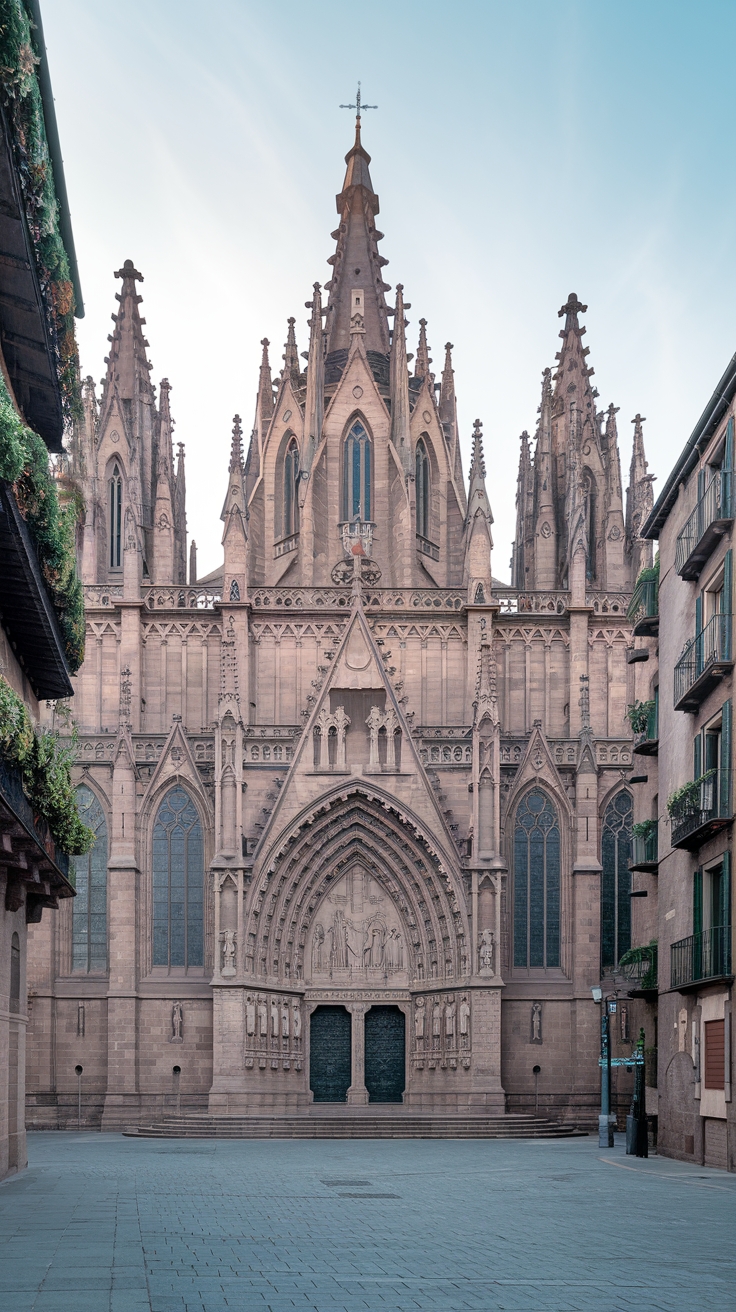
The Barcelona Cathedral is the perfect starting point for your tour. Unlike the more famous Sagrada Familia (which isn’t in the Gothic Quarter), this is the real deal when it comes to Gothic architecture.
What Makes It Cool
The cathedral’s official name is a mouthful: the Cathedral of the Holy Cross and Saint Eulalia. It was built between the 13th and 15th centuries, though the fancy neo-Gothic facade was added much later in the 19th century.
Highlights to look for:
- Architectural features: Flying buttresses, creepy-cool gargoyles, and an 85-meter-long central nave
- Choir stalls: Intricate woodcarvings that tell stories in themselves
- Peaceful cloister: Beautiful garden with white geese (yes, actual geese live there!)
- 28 side chapels: Each with unique artwork and history
- Santa Eulalia’s crypt: Below the altar, holds the tomb of Barcelona’s co-patron saint – a 13-year-old girl martyred by the Romans
- Rooftop access: For just €3, take an elevator up for amazing views of the Quarter’s maze-like streets and glimpses of the Mediterranean
Tips for Your Visit
Quick facts for planning:
- Opening hours: 8:30 AM to 12:30 PM and 1:30 PM to 5:30 PM most days (varies on Sundays/holidays)
- Cost: Free during worship hours, €9 for cultural visits (includes audio guide)
- Dress code: Modest attire required – shoulders and knees must be covered!
- Time-saver tip: If pressed for time, focus on the cloister, choir area, and Santa Eulalia’s crypt
- Skip the paid audio guide: The cathedral’s volunteer docents offer superior insights during weekday afternoon visits.
2. El Pont del Bisbe (Bishop’s Bridge)
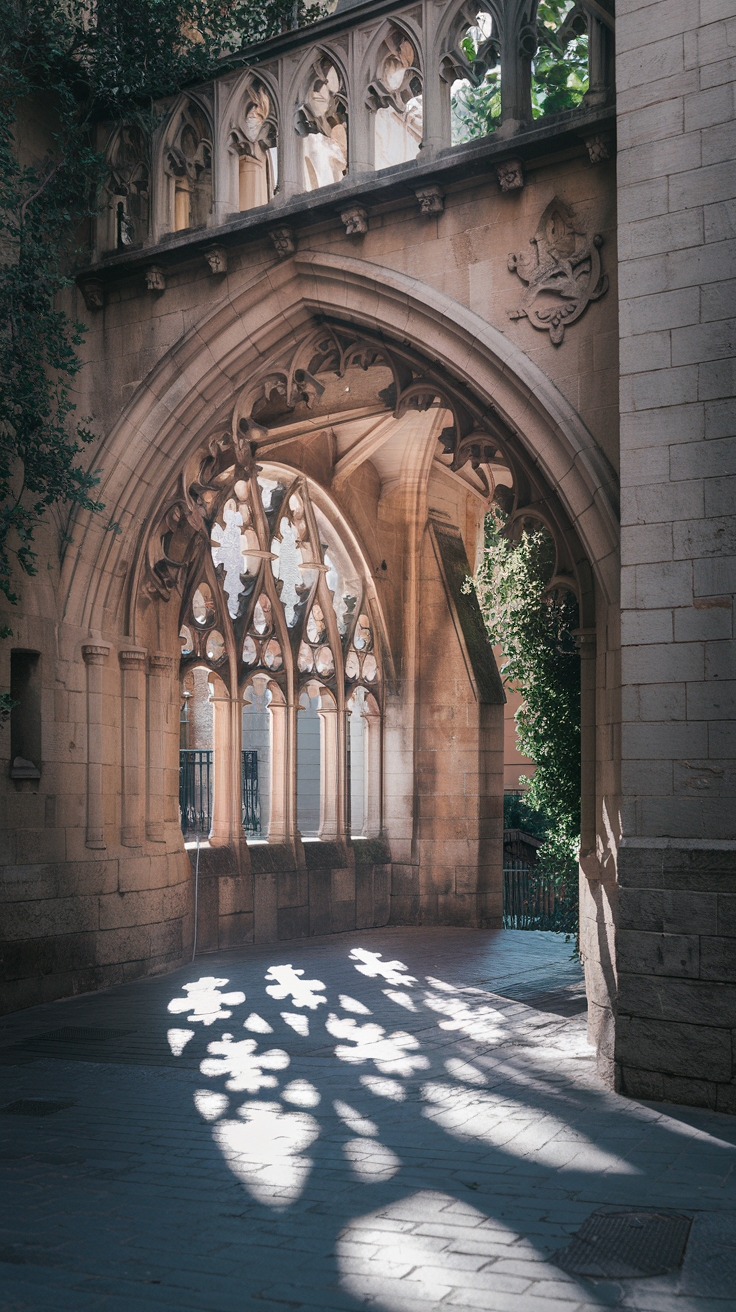
Just a three-minute walk from the Cathedral is one of the most Instagrammable spots in the Quarter. The Bishop’s Bridge spans Carrer del Bisbe (Bishop’s Street) and connects two important buildings.
Not As Old As It Looks (But Still Super Cool)
Here’s a fun fact that surprises most visitors: despite looking totally medieval, El Pont del Bisbe was actually built in 1928 by architect Joan Rubió i Bellver. It was constructed in neo-Gothic style for the 1929 Barcelona International Exposition, but it blends in so perfectly with the surrounding medieval buildings that most people have no idea it’s relatively new.
The bridge has some amazing carvings and arches, but the coolest feature is a small skull with a dagger through it. According to local legend, if you walk under the bridge and look at this skull, you’ll fall under a curse! Another version of the story says the architect added the skull as a secret curse on city officials who rejected his bigger plans for renovating more of the Gothic Quarter. Spooky, right?
Photo Tips
For the best pics of the bridge, get there early before the street gets packed with tourists. The bridge is accessible 24/7 since it’s over a public street. Morning light is best for highlighting all the detailed stonework. Don’t forget to look up and spot the skull and dagger – but maybe don’t stare too long if you’re superstitious! You only need about 10-15 minutes here, making it a quick stop on your itinerary.
3. Palau de la Generalitat de Catalunya
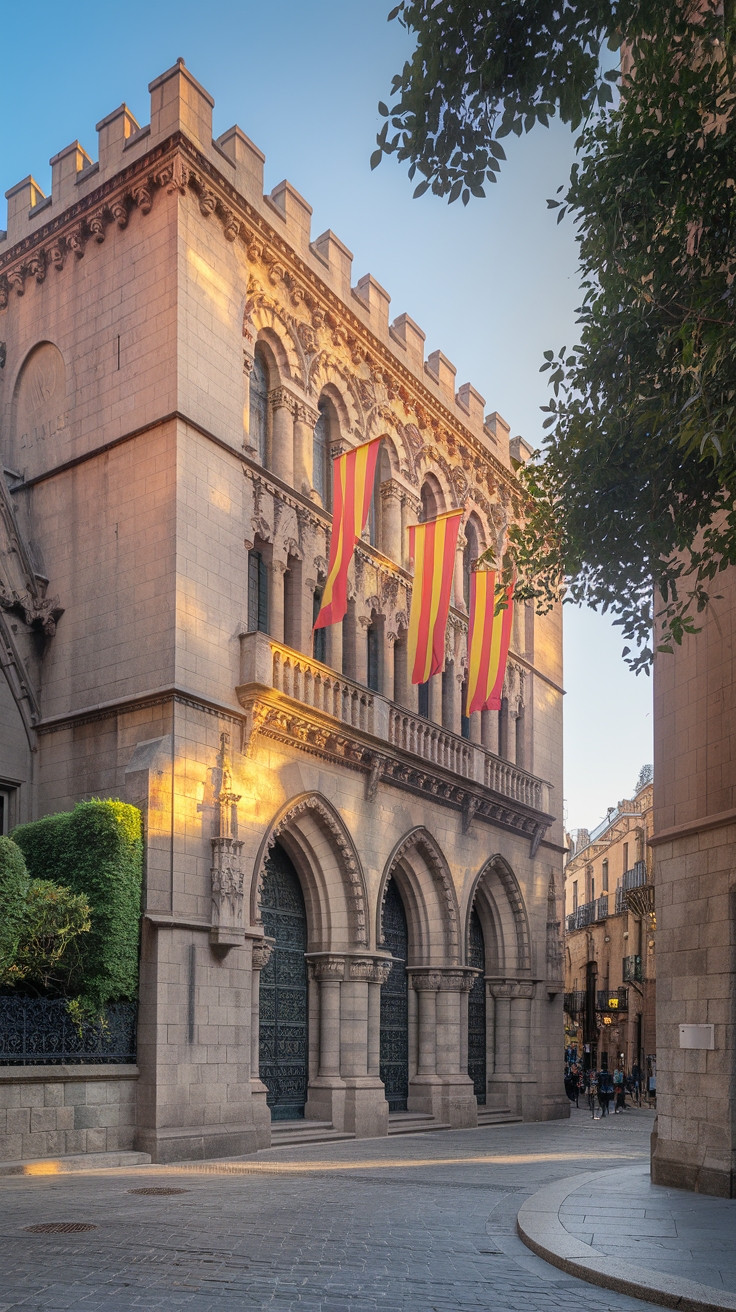
Connected to the Bishop’s Bridge is the impressive Palau de la Generalitat, one of Barcelona’s most important political buildings. This palace has been the seat of Catalan government since medieval times and still functions as the headquarters of the Presidency of the Generalitat de Catalunya today.
A Building That Spans Six Centuries
The Palau is a cool mix of architectural styles spanning over 600 years. Construction started in the late Gothic period (15th century) with Renaissance and Baroque additions coming later. The most impressive part is the main facade on Plaça de Sant Jaume, completed in the early 17th century in Renaissance style, which creates a beautiful contrast with the original Gothic courtyard and ceremonial staircase inside.
The interior courtyard is called Pati dels Tarongers (Orange Tree Courtyard) and is filled with bitter orange trees that symbolize prosperity. Inside, the Gothic Hall (Saló de Sant Jordi) has amazing stained glass windows and detailed woodwork showing off the best of Catalan craftsmanship through the ages.
What You Can Actually See
Since it’s a working government building, you can’t always go inside. The interior is only open to the public on specific days: April 23 (Sant Jordi Day) and one weekend per month (usually the second weekend).
If your cruise visit doesn’t line up with these open days, you can still check out the impressive facade from Plaça de Sant Jaume and sometimes peek into the Gothic entrance hall from the main doorway, which is often open during business hours with security standing by.
Even from outside, you can get great photos of the Renaissance facade and the Saint George statue above the entrance – Saint George (Sant Jordi) is Catalonia’s patron saint.
4. Plaça del Rei (King’s Square)
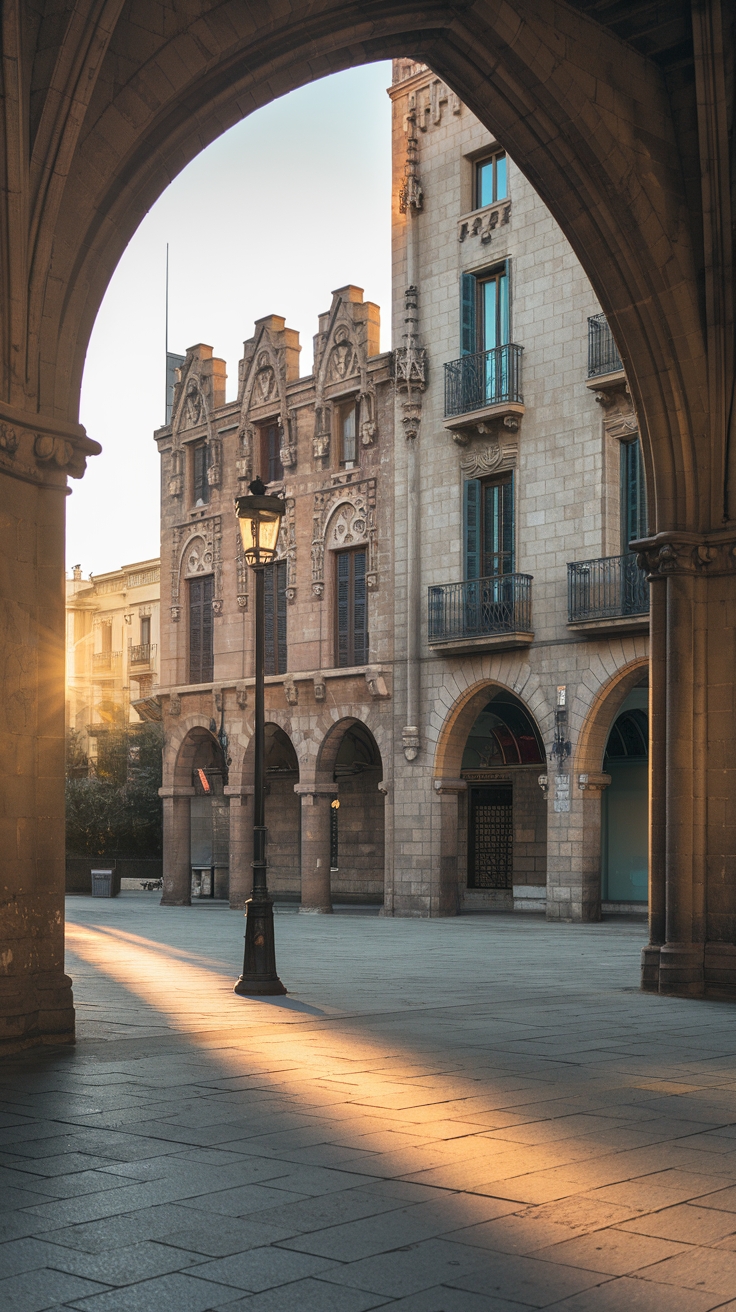
A short walk from the cathedral is Plaça del Rei, one of the most atmospheric medieval spaces in the Gothic Quarter. This completely enclosed square feels like stepping into a time machine, surrounded by important royal buildings from different periods. Stand in the center and you can almost feel what medieval Barcelona was like when this square was the heart of royal power.
Royal Buildings All Around
The square is dominated by the impressive Palau Reial Major (Grand Royal Palace), where the Counts of Barcelona and later the Kings of Aragon lived. The palace complex includes several cool structures:
Key buildings to check out:
- Saló del Tinell: A massive rectangular hall with huge stone arches
- Built in the 14th century as a throne and banquet hall
- Historical claim to fame: Christopher Columbus was received here by Ferdinand and Isabella after his first voyage to America!
- Torre del Rei Martí (Martin’s Tower):
- 14th-century watchtower, six stories high
- Tallest medieval structure in the Gothic Quarter
- Provided defense while offering spectacular views of Barcelona and its harbor
- Chapel of Santa Àgata:
- The royal family’s private chapel
- Features beautiful Gothic architecture
- Houses a remarkable altarpiece by Jaume Huguet from 1465
Underground Roman Ruins
The coolest part about visiting Plaça del Rei is the entrance to the Barcelona History Museum (MUHBA), located in the Palau Reial. The museum’s highlight is an incredible underground archaeological site beneath the square that reveals extensive Roman ruins of Barcino (Roman Barcelona), including streets, homes, and workshops from the 1st-6th centuries AD.
The museum takes you on a journey through Barcelona’s history, starting with the Roman ruins at the bottom and working upward through the ages. For cruise visitors with limited time, it’s an efficient way to understand how the city evolved over 2,000 years.
Quick Facts for Visitors
Plaça del Rei itself is free and accessible at all hours. The History Museum costs about €7-10 and is open Tuesday through Sunday from 10 AM to 7 PM (closed Mondays except holidays). Give yourself at least 1-1.5 hours if you want to explore the museum thoroughly, or 20-30 minutes just to appreciate the square’s architecture from the outside.
5. Church of Santa Maria del Pi

A short walk west of the Cathedral is the Church of Santa Maria del Pi, an awesome example of Catalan Gothic architecture that many visitors miss as they rush between more famous landmarks. The name “del Pi” refers to a pine tree that once stood in front of the church, and there’s still a pine tree in the adjacent plaza today, keeping the tradition alive.
That Amazing Rose Window
Santa Maria del Pi was built between the 14th and 15th centuries, with a super-clean, austere exterior that’s typical of Catalan Gothic style. Unlike the fancier French Gothic churches, Santa Maria del Pi keeps it simple with clean lines and large, open interior spaces. The facade features a stunning rose window nearly 10 meters in diameter – one of the largest in Catalonia.
The church’s interior is a single huge nave without side aisles, creating a massive open space covered by ribbed vaults. This design creates amazing acoustics, which is why the church often hosts classical and choral concerts today – perfect if your cruise happens to stay overnight!
Inside, you can check out twelve side chapels and a 14th-century baptismal font. The bell tower stands 54 meters tall and has survived earthquakes, lightning strikes, and even bombing during the Spanish Civil War. Talk about resilient!
Hidden Gems
For a few extra euros, you can access the church’s rooftop and bell tower, giving you unique views of the Gothic Quarter and beyond. There’s also a small museum next to the church displaying religious artifacts, including an impressive collection of silverwork saved from fires that damaged the church during the 1936 civil unrest.
The square in front of the church, Plaça del Pi, often hosts local artisan markets selling Catalan crafts, honey, and specialty foods – perfect for grabbing authentic souvenirs during your cruise stop. The church is open for visits Monday through Saturday from 10 AM to 6 PM and Sundays from 4 PM to 8 PM, with an entrance fee around €5.
6. Els Quatre Gats (The Four Cats)
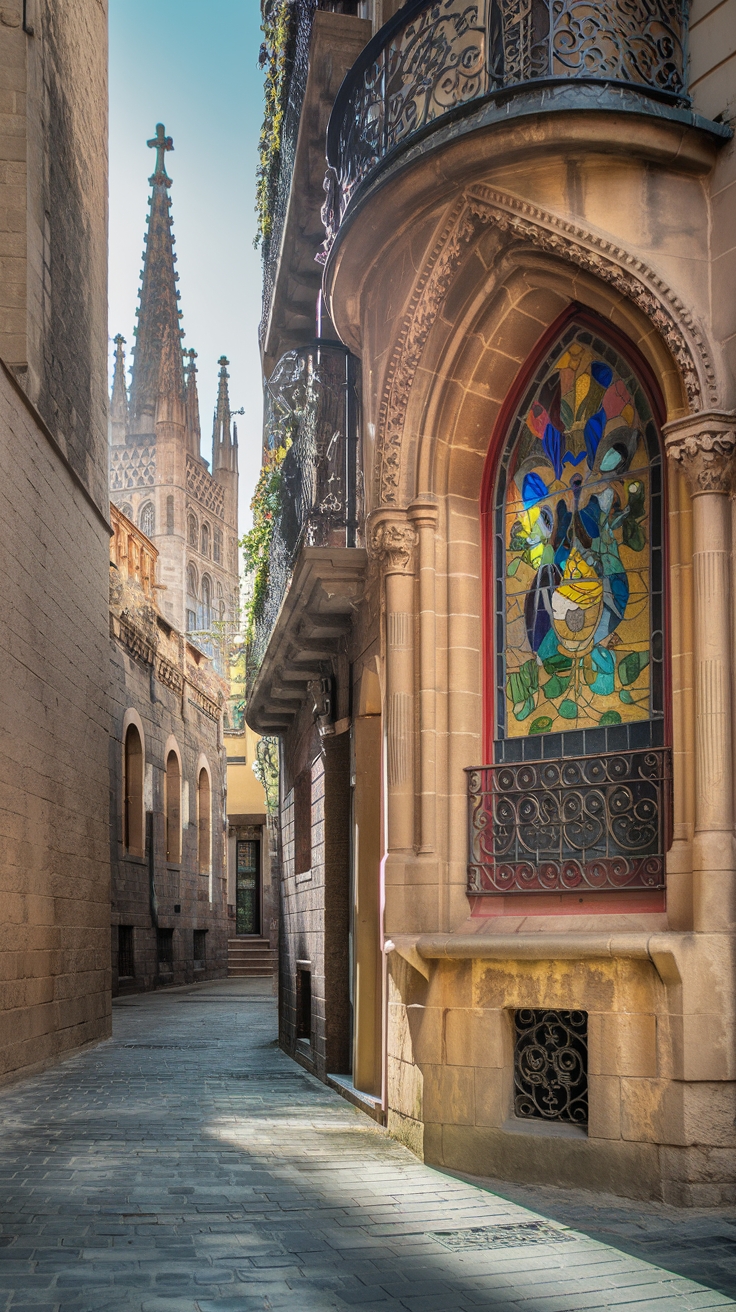
While the Gothic Quarter is famous for medieval buildings, it also has some cool modernist treasures. Els Quatre Gats, located on Carrer de Montsió just inside the Gothic Quarter, bridges the gap between medieval Barcelona and the artistic revolution of the late 19th century.
Where Picasso Had His First Exhibition
Opened in 1897 in a medieval building renovated by architect Josep Puig i Cadafalch (who was working at the same time as Gaudí), Els Quatre Gats was inspired by Paris’s Le Chat Noir cabaret. The place quickly became Barcelona’s hotspot for avant-garde artists, writers, and intellectuals during Spain’s Modernisme movement. Its biggest claim to fame? It hosted Pablo Picasso’s first solo exhibition in 1900, when the artist was just 19 years old!
The interior still has its original modernist details, including wrought iron elements, decorative tiles, and arched windows. Old photos on the walls show famous patrons including Picasso, architect Antoni Gaudí, and composer Isaac Albéniz. The name “Four Cats” is actually a Catalan expression meaning “just a few people,” though it quickly became THE gathering place for Barcelona’s cultural elite.
What to Do There
Today, Els Quatre Gats is a restaurant and café where you can experience a piece of Barcelona’s artistic heritage while enjoying Catalan food. If you’re short on time, even stopping for a quick coffee or vermouth at the bar lets you soak up the atmosphere of this cultural landmark.
After your cultural immersion, you might want to experience some of those Barcelona eats way better than cruise food.
It’s typically open daily from 10 AM until midnight. You don’t need reservations for café service, though dinner reservations are recommended (but rarely needed for lunch). Prices are a bit higher than average because of the historical significance, but sitting where Picasso and other artistic legends once gathered? Priceless!
7. Casa Clariana Padellás (Barcelona History Museum)
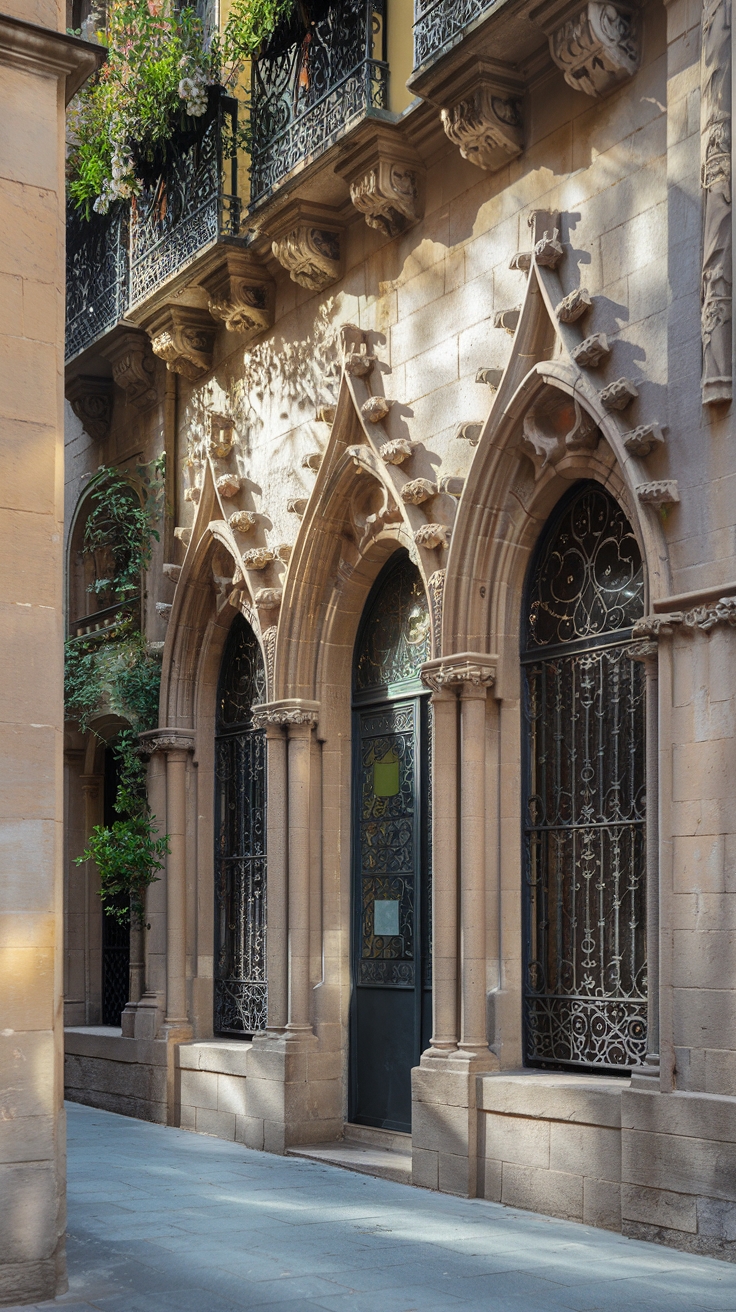
Our final architectural gem brings Barcelona’s story full circle. Casa Padellás is a 15th-century Gothic mansion that now serves as the main entrance to the Barcelona History Museum (MUHBA) we mentioned earlier when talking about Plaça del Rei. The building itself is a perfect example of a Gothic Catalan urban palace.
A Building That Was Moved Stone by Stone
Here’s a wild fact: Casa Padellás wasn’t originally in the Gothic Quarter! It was moved stone by stone in the 1930s from its original location on Carrer Mercaders during the opening of Via Laietana, Barcelona’s first major urban renewal project. During excavation for rebuilding, workers discovered extensive Roman ruins beneath, which led to the creation of the archaeological museum that now occupies the site.
The facade shows off classic Catalan Gothic civil architecture with symmetrical stone construction, rectangular windows, and an interior courtyard with an elegant external staircase – architectural elements that would influence buildings throughout Barcelona’s history. The interior now houses museum exhibitions that tell Barcelona’s story from Roman colony to medieval powerhouse.
Roman Ruins Under Gothic Architecture
The coolest thing about visiting Casa Padellás is the contrast between the Gothic architecture above and the extensive Roman ruins below. The underground archaeological site shows daily life in Roman Barcino with amazingly preserved sections of streets, homes, wine-making facilities, and dyeing workshops from the 1st-6th centuries AD.
This layering of history in one location perfectly illustrates Barcelona’s continuous evolution and makes an ideal final stop on your Gothic Quarter tour. The museum’s chronological approach helps you understand how all the buildings you’ve seen throughout the day fit into Barcelona’s bigger historical picture.
Visitor Info
The museum is open Tuesday through Sunday from 10 AM to 7 PM and closed on Mondays (except holidays). Entrance costs about €7-10, with various discounts available. Set aside at least 1 hour to appreciate the building and Roman ruins, though history buffs could easily spend 2-3 hours exploring all exhibits.
Getting the Most Out of Your Gothic Quarter Visit
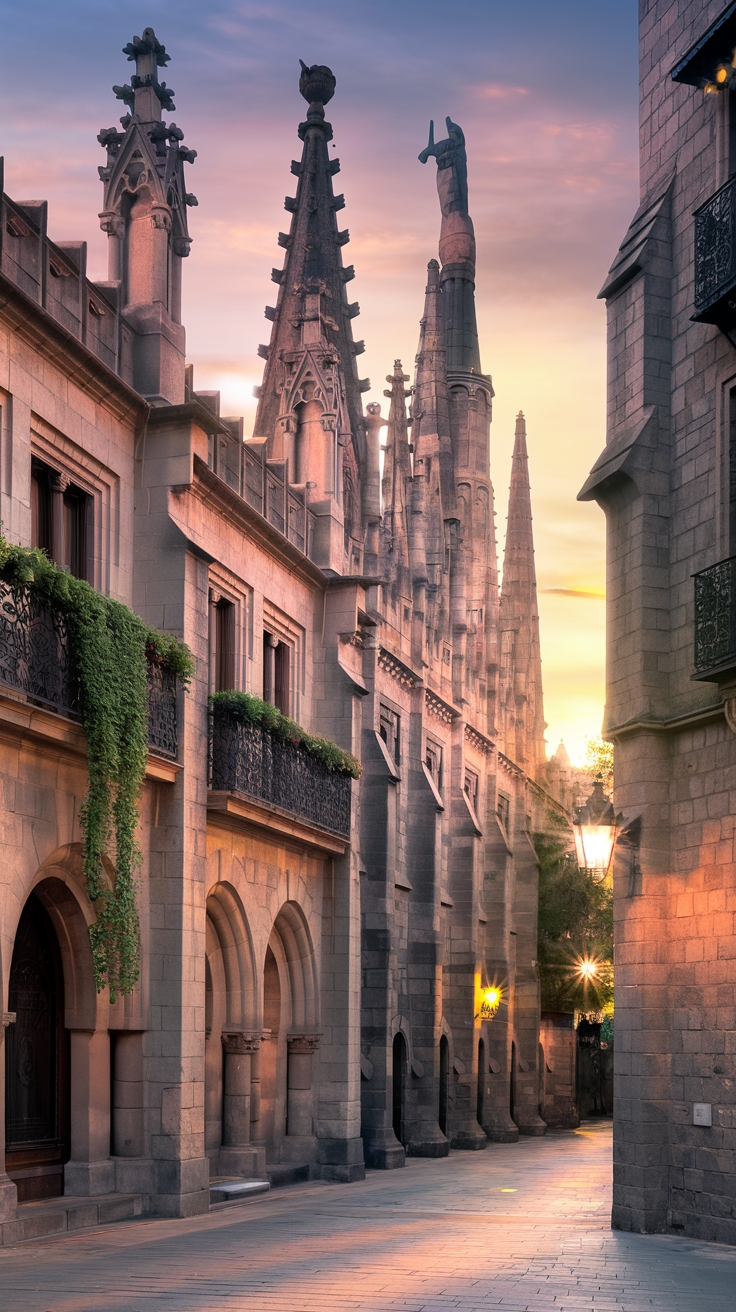
After exploring these seven architectural treasures, you’ll have experienced Barcelona’s evolution from Roman colony to medieval power to modernist hotspot. These buildings are arranged in a logical walking route that minimizes backtracking and allows for efficient exploration even during a short port call.
Pro Tips for Cruise Passengers
To make your Gothic Quarter experience awesome:
- Comfort & Preparation
- Wear comfy walking shoes – those cobblestone streets are uneven and will destroy fancy footwear
- Bring a water bottle and plan for a mid-tour coffee break at one of the quarter’s historic cafés
- Download a Gothic Quarter map to your phone before leaving your ship (narrow streets mess with GPS)
- Timing & Strategy
- Visit early (before 11 AM) to avoid the worst crowds, especially during summer cruise season
- Consider a guided walking tour if you’re super short on time
- Leave 30-40 minutes of “wandering time” to discover hidden squares and photogenic corners
- Safety & Practical Matters
- Keep valuables secure – the narrow, crowded streets are pickpocket heaven
- Carry some cash for small shops and cafés that might not accept cards
- Know a few basic Spanish or Catalan phrases – locals appreciate the effort!
Getting Back to Your Ship
Allow 45 minutes minimum for return journey, especially from distant terminals. Taxis cluster around major squares like Plaça de Catalunya and Plaça de Sant Jaume. The T3 bus return stop is at Columbus Monument—look for crowds of cruise passengers and blue bus signage.
Emergency backup: If you’re cutting it close, taxis from the Gothic Quarter to any cruise terminal shouldn’t exceed €20 including port surcharge. Expensive but better than missing departure. For parking information if you’re driving, check our Barcelona cruise port parking guide.
Common Questions
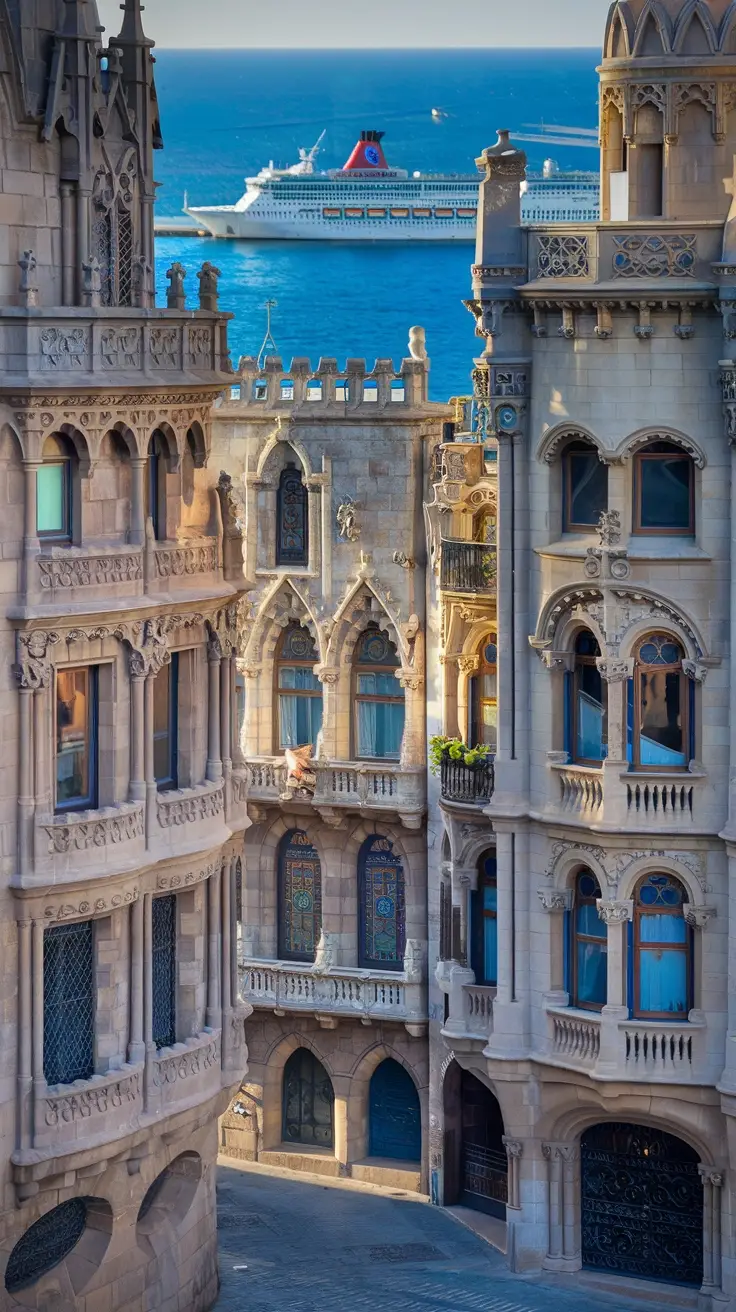
How long do I need for all seven buildings? Allow 3-4 hours for a complete visit including interior access where possible. Rushing through in 90 minutes means you’ll miss architectural details and historical context that make these buildings significant. If you have a 6-hour Barcelona itinerary, the Gothic Quarter fits perfectly as your cultural centerpiece.
Can I visit everything in one day during a cruise stop? Absolutely, but start early. Begin around 9 AM to avoid crowds and allow time for unexpected discoveries. The Quarter rewards wandering, and rigid schedules kill the experience. For families, check our Barcelona cruise port with kids guide for additional considerations.
What’s the best walking route? Start at Barcelona Cathedral, move to Plaça del Rei for the history museum, then work your way through the smaller streets hitting Santa Maria del Pi, Els Quatre Gats, and ending at the Generalitat. The Bishop’s Bridge makes a perfect photo stop between major sites.
Are there entrance fees for everything? Cathedral and history museum charge admission (€14 and €7-10 respectively). Church of Santa Maria del Pi charges €5. Street-level architecture viewing is free, and sometimes that’s the best perspective anyway.
How do I avoid the worst crowds? Visit Tuesday-Thursday mornings before 11 AM. Weekends and Monday afternoons bring the heaviest foot traffic. Cruise ship passengers typically hit the Quarter between noon-4 PM, so early morning exploration rewards you with better photography opportunities and shorter lines.
Is it safe to wander the narrow streets? Generally yes, but pickpocketing targets tourists in crowded areas. Keep valuables secure, avoid displaying expensive electronics, and trust your instincts if a situation feels uncomfortable. The Quarter’s maze-like layout can disorient first-time visitors, so download offline maps before leaving your ship. For comprehensive safety tips, see our Barcelona cruise port safety and scams guide.
The Real Rewards
Barcelona’s Gothic Quarter offers cruise passengers something increasingly rare: authentic architectural experience without theme park sanitization. Yes, some “medieval” elements are Victorian additions, and tourist crowds can overwhelm narrow streets. But genuine Gothic stonework still anchors spaces where Romans built temples, medieval kings held court, and modern artists launched careers.
The Quarter’s greatest gift isn’t any single building—it’s the layered experience of walking through 2,000 years of architectural evolution. Roman walls support Gothic arches that connect Renaissance facades to modernist cafés. Tourism officials promise “medieval atmosphere,” but the real attraction is watching civilizations build upon each other’s foundations.
Want to capture the perfect shot? Check our Barcelona photo spots guide for the best angles and lighting tips. For rainy days, our Barcelona rainy day cruise port guide offers covered alternatives that still showcase the city’s architectural heritage.
If your bags need upgrading for future travels, I recommend checking out Level8 Cases for reliable travel luggage that handles cruise and city exploration equally well.
For accessibility considerations, our Barcelona cruise port accessibility guide covers wheelchair access, mobility-friendly routes, and adaptive touring options throughout the Gothic Quarter and beyond. Looking for authentic local flavors? Explore our Barcelona tapas bars guide to discover where locals actually eat, far from the tourist-trap restaurants that crowd Las Ramblas.
Last Updated: 26 October 2025